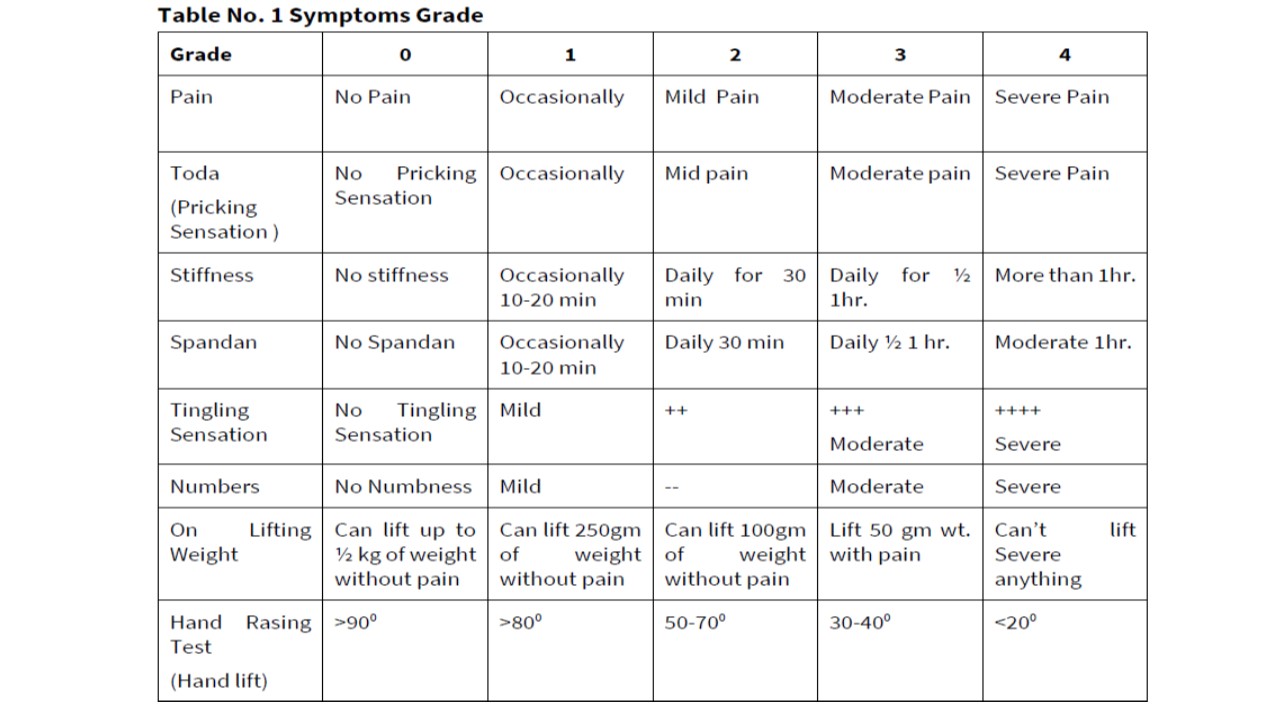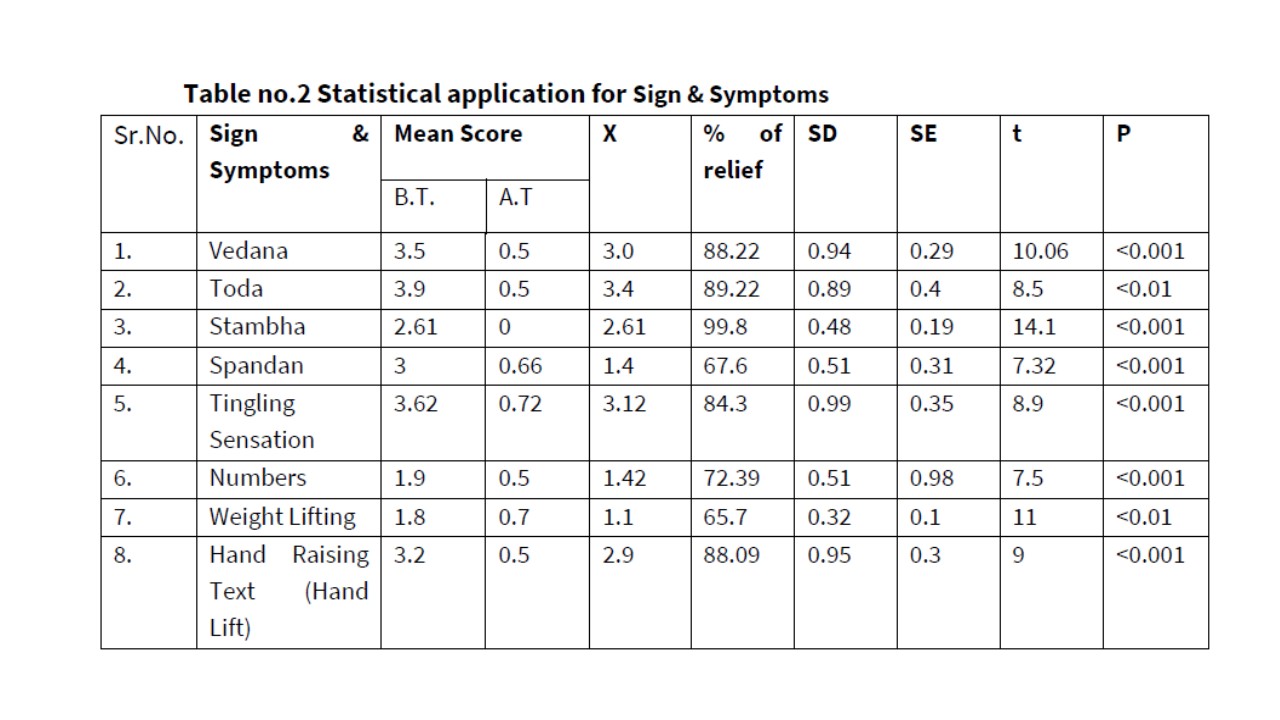Original Article
Year: 2021 |Volume: 2 | Issue: 06 |Pages: 24-29
TO EVALUATE THE CLINICAL EFFICACY OF “AGNIKARMA” IN THE MANAGEMENT OF AVABAHUKA (FROZEN SHOULDER)
About Author
Correspondence Address:
Dr. Abhay Kadu Professor & HOD Dept. of Rasashastra & Bhaishayjya Kalpana. Jupiter Ayurvedic College, Nagpur – 441 108 E-mail – drabhaykadu10@gmail.com (Mobile no. 9850408980)
Date of Acceptance: 2021-06-25
Date of Publication:2021-07-07
Article-ID:IJIM_84_08_21 http://ijim.co.in
Source of Support: Nil
Conflict of Interest: None Declared
How To Cite This Article: Kadu A, Rewatkar M. To Evaluate the Clinical Efficacy of “Agnikarma” in the Management of Avabahuka (Frozen Shoulder).Int. J Ind. Med. 2021;2(6):24-29
Abstract
Avabhuka is a shoolpradhan Nanatmajvata Vyadhi. It is one of the Eighty types of Vata Vyadhi described in Ayurvedic Text. The main symptom of the diseases is pain in shoulder region with rigidity. Radiating pain travels from neck, shoulder, upperarm, elbow and towards forearm. The symptom of Avabhuka is closely resembles with the clinical features of frozen shoulder where the suprascapular nerve and axillary nerve of one or both the arm are involved. Frozen shoulder is one of the major causes of illness in the working populations in a developing country. Agnikarma with panchdhatu shalaka (Alloy metal rod) shows very promising result. By washing the site by Trifala Kadha and when given till samayak dagdha lakshan appears and sounds with foul smell. A mixture of Yastimadhu Ghrut with honey is applied over the site. Sterile bandage is applied to avoid outside exposure and moisture. This procedure is done once in a week for three weeks in a sample size of (N=30) and regular follow up was taken. Result obtained were revealed that there is statistically significant improvement in the symptoms of Avabhuka. Agnikarma was well tolerated, comfortable, economical for the patients. There were no side effects noticed and can be done on OPD basis. Therefore, this procedure gives new approach in the clinical management of frozen shoulder.
Keywords: Vatavyadhi, Avabahuka, Frozen Shoulder, Agnikarma, Dagdha
Introduction
Avabahuka is one among the Eighty types of Vatavyadhi. Symptoms of Avabhuka in closely resembles to the clinical features of frozen shoulder. Frozen shoulder is a severe painful condition where suprascapular Nerve of one or both the arms are involved. Present study was undertaken to Evaluate the Clinical Efficacy of Agnikarma (with cauterization) in the Management of Frozen shoulder. The most important symptoms are Radiating pain from neck to shoulder region then to upper Arm, Elbow and fore arm with restricted movement.
The management provided by modern medicine for the condition is Either conservative like Rest, Immobilization, Analgesic, and Anti-inflammatory drugs, physiotherapy etc. or surgical procedure. If the pain and neurological findings do not disappear prolonged conservative treatment is advised. But prolonged Analgesic or Surgical procedure is not the ultimate solution. There is a common problem of Recurrence and some patients lose their job or working capabilities.Hence considering above facts this study has been planned with Aim & objectives to evaluate the effect of Agnikarma in the management of Avabahuka (Frozen shoulder).In Ayurvedic text Basti, Siravyadh (Venepucture) etc. was advised in our study Agnikarma was advised weekly. In 30 patients of Ambahuka. The signs and symptoms were assessed before and after the treatment based on the grading. Result obtained are analysed for the statistical significance using paired ‘t’ test, which revealed that there statistically significant improvement in symptoms of Avabahuka. Ideally this technique should be evaluated scientifically using principles of Biophysics and nerve conduction studies.
Avabahuka is a Shoolpradhana Nantnaj’s Vatavyadhi which affects the daily routine of the patients. [1] Patient suffering from Avabhaka not capable of do simple movement of Arm. Like Adduction of Abduction. [2,3] ‘Avbhukka is one of the vatavyadhi which starts from shoulder or neck and gradually the pain and stiffness produce radiating pain progress towards upper Arm, Elbow and Forearm. There may be stiffness in shoulders, distress or piercing pain in shoulder joint. Frozen shoulder is a major cause of illness among the working population in developing countries. This is the most common disorder which effect the movements of arm/ shoulder particularly in productive period of the life.
By Ayurvedic approach various treatment modalities like Siravedha, Bastichiksta or palliative medicines are also useful. But Agnikarma procedure seems to be more effective by providing timely relief. It is a classical fact that the pain is effectively relieved by the Agnikarma. There is a no fear of petrification or Bleeding. Ultimately it produces balancing effect on vitiated Vatadosha. To perform this procedure many things are used such as Ajadant, Godant, Kshara, Shalaka, Pippali, Haridra khand, Madhu, guda etc. and different types of metals are used.
Aim & Objective :
To Evaluate the therapeutic (clinical) Efficacy of Agnikarma in patients of Avabahuka w.s.r. to Frozen shoulder.
Material and Methods :
Study was performed on OPD Basis. Patients are selected on the basis of signs and symptoms given in our Ayurvedic text. Thus 30 patients of clinically diagnosed with “Avabahuka” was selected.
Inclusive Criteria
Patients having classical symptoms of Avabahuka like pain in sholder joint. Radiating from neck to upper arm, elbow and fore arm. Numbness, stiffness, pricking pain, tingling and difficulty in raising arm. Age group of 35 to 75 yrs. were selected.
Exclusive Criteria :
Patients with Spondylolisthesis, sacroiliac arthritis, fibrosis of sholder joint, prolonged shoulder stiffness, herpex simplex infection causing radiating pain. Patient suffering from tuberculosis, diabetic neuropathy, patient with multiple wound, fractures of vertebra, disc prolapse or PIVD etc. patients with pitta prakurti where agnikarma is contraindicated.
Study Criteria :
30 patients with their own consent are included in this study criteria. To study the outcome variables before treatment and after treatment on 7th day, 14th day and on 21st day after treatment were recorded.
Criteria for assessment
Subjective Parameter
All the symptoms were given scoring depending on their severity.
Objective Parameter
Scoring was adopted to the improvement in the arm and shoulder movement.
Investigation :
CBC, RBS were carried out to rule out any other disorder before treatment (As per willingness of patients).
Treatment Protocol :
A samayak dagdha is given by red hot tip of Panchdhatu shalaka on the shoulder region & the tender points of suprascapular and axillary nerve path. Then yashtimadhu ghrut with honey is applied on it.
Duration of treatment : Four weeks
The improvement in the patient was assured on the basis of relief in the cardinal symptoms of the disease. To assess the effect of therapy following scoring pattern was used.

Table No. 1 Symptoms Grade

Table no.2 Statistical application for Sign & Symptoms
Procedure :
The procedure of Agnikarma was conducted on OPD basis. The material used for Agnikarma was “Panch Dhatu Shalaka”. The procedure of Agnikarma was explained to the patient in detail and assurance is given. All Aseptic precautions are taken. Patient was advised to consume Snigdha –Picchila food before treatment on the day of procedure. Patients are told to sit on chair with relaxed arm and shoulder. They are instructed to relax and slowly made to change the position of arm & shoulder as required. A Samayak Dhagad is given on specific points. (Twachagat).
Poorva Karma : (Pre-procedure)
Informed concern to undergo Agnikarma treatment was taken. Routine Blood Investigations done. Selected site was cleaned by Triphala Kawth.
Pradhan Karma : (Procedure)
Perticularly centre of the Anterior and posterior border of shoulder joint is chosen. About 15-30 points are marked with a pain. Along the muscular branch of Axillary nerve, at the same time maximum tender points are choosed along with the path of suprascapular nerve giving space of 1 cm between each point. The panchdhatu shalaka with sharp point was heated over the burning gas stove and it became red-hot. Agnikarma performed with this red hot metal rod. At the marked points in a form of Bindu Kruti in such a way that the samayak dagdha laksha was appeared and sounds with foul smell.
PASCHATKARMA (Post Procedure)
Immediately after Agnikarma a mixture of yashtimadhu ghrut and honey is applied over the site. Sterile Bandage was applied to avoid outside Exposure.The patients are advised to sit for while and then send to home.
Discussion
Agnikarma has been given special place in shalya tantra by Acharya sushrut. It is belied that, diseases treated by Agnikarma never reoccurs [5]. Agnikarma was well tolerated, comfortable for all the patients. There were no side effects noticed in any of the patients. The procedure was simple, economical and can be done on OPD basis. This procedure gives instant relief to most of the patient but to avoid the recurrence of the disease and to break the “Samprapti”. They may continue oral ayurvedic medicines. Therefore, agnikarma is a new opportunity in the clinical management of Avabahuka (Frozen Shoulder).
Moderate significant result with P value <0.01 seen in case of toda and spandan. It is found that the patient was clinically improved with the treatment of Agnikarka with no side effect of the therapy. About 88% of relief found in case of pain immediately after the treatment. Therefore, patient become more comfortable and mentally satisfied by the treatment. 89% relief in Toda and about 99% relief was seen in case of stiffness after the therapy. Agrnikarka cures all the Vataj Shool or pain which occurs anywhere in the body due to vitiated vata dosha. As Ayurveda believes that being ushna treatment of Agnikarma acts against the property of vata so cures vataj disorder. In this study effect of therapy shows highly significant with “P value” <0.001. Result in Vedna, Stambha, Tingling Sensation of upper Arm and for arm there was remarkable improvement. In numbness, hand raising and weight lifting by Arm also give remarkable Recovery giving p value <0.001.
Conclusion
Agnikarma therapy shows highly significant results in all signs and Symptoms especially in case of pain “as it is one of the most uncomfortable factor for the patient. The entire treatment on the patient was advised to remove the bandage after 3 hrs. He was advised to keep the area clean and free from moisture. The second course of Agnikarma was conducted on 7th, 14th and 28th day respectively.
References
value="
- Charak Samhita of Agnivash (IIIrd edition) Varanasi, chaukhambha Surbharti Prakashan. (Both purvardha and uttardha) Reprint 2005, Sutrasthan (20/11) pg.399. 2
- Shrush Samhita, purvardha and uttardha, chaukhambha publication, edition: Reprint 2010, Nidansthana (1), sutrasthana (12/3, 4,8) pg. 50, 51 Dr. Indra Devtripathi, charakpanidatta virachit chakradatta, edited by prof. Ramanathdwivedi, chaukhambhasanskrit bhawan, Varanasi edition reprint 2014, vatavyadhichikatsaprakaran (22/54) pg 136, Chaturvedisonalet, at,, journal of biological & scientific opinion, volume 2, 2014.
- Ashtang Hruday, nidansthana (15/42) Prof. Shrikiant Murty. Chaukhambha Academy, Varanasi Reprint 2005.
- Viddha & Agnikarma Chikitsa by Dr. R.B.Gogate (Vidya Mitra Prakashan, Pune), Date of publication Jan. 2004, P.32.
- Chaturvedi Sonal, et. al. Journal of Biological and scientific opinion. Volume 2(1), 2014.
"

